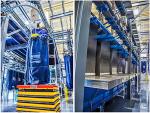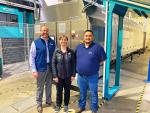GREENVILLE, S.C. — To Doug Story, president of UNX-Christeyns’ LL Division, laundry operations today are manufacturing facilities.
“You have heard me say this before, and I keep pushing on it, because we are now manufacturing,” he says. “We bring a raw material in, dirty linen. We process it, and we send it out the door.
“In today’s laundry operation we have now moved to that point where we are continuous process. Think about the linen. The only time a human being touches a linen is when they’re pulling out the linen at the soil sort.
“No one touches it, depending on how long it takes, and then it comes out and goes to a robot that carries it and drops it into the facility. So, we are now a continuous manufacturing process, for the most part.”
Story shares that a continuous production process is consistent, constant and uninterrupted.
In manufacturing, a continuous process is a method that is used by manufacturing or production companies to churn out the greatest quantity of a product over the least amount of time.
This is consistent, constant and uninterrupted—in contrast to batch processing. In laundry, Story says the operation of a tunnel washer is the example of a continuous process, similar to the operations that take place in manufacturing plants.
The question is how does an operator ensure quality control on a continuous process?
“Do we want the customer to be our quality control directory?” Story asks.
He explored these questions and more during the Association for Linen Management (ALM) educational session “High Speed. High Quality. No Problem.”
CONTINUOUS PROCESS QUALITY
Story says that the key to maintaining quality goods in a continuous laundry process is by measuring. The well-known saying in the industry is, “If it is not measured, it doesn’t happen.”
“How can you talk about how good your plant is doing if you do not really know?” he says. “Do you really know? Most of these large plants are shoveling stuff through them so fast. Do you really know, or at least have an estimate, of how your quality is doing?
“The faster and faster you go, the less likely you’re going to know.”
But how can a laundry be sure with systems that change on the whim of equipment or on the demands of the facilities/customers it serves?
Set standards, says Story. For example, what is an acceptable stain? “Is it the size of your thumbprint? The size of a quarter?
“Those are the kinds of different standards you can set within your process.”
Then, collect, measure and interpret data about the operation relating to the standards. He does note that these suggestions can be put into place for the washer-extractor batch process.
He says the quality control process for continuous manufacturing follows this basic pattern of examination:
- The raw materials go into the system.
- Check at the first mix point.
- Check at the middle mix point.
- Check at the endpoint.
- Check at the final product cure point.
Automation has replaced many of the manual processes that were used in the past, but laundry operations still need to engage a quality control process.
Story says the quality control process for “continuous clean fabric manufacturing” should look some like this:
- The raw materials go into the system—soil sort. Too often, according to Story, this is simply dirty linen being sent through for processing. However, the “raw materials” need to be examined for damage (tears, tape, dye, etc.) and should be sorted into their own classification as these are actually “out-of-specification raw material.”
- Check at the first mix point. Titrations done of the early stages of wash process to meet specifications. Source water analysis. Look at temperatures, load sizes, water levels, time and wash formula selection.
- Check at the middle mix point. Further titrations to meet specifications. Again, examine temperature, water levels and time.
- Check at the endpoint. Final titrations and sampling of temperature, water levels, time and finishing pH.
- Check at the final product cure point. Finishing is where most operations lose control over their quality control as the production speeds are pushed higher, Story points out.
“Touch and eyeballs” were the final stage of quality control in laundry operations for many years, but those days are going away, he says.
Story goes on to say that there is a whole science of quality control methods of continuous systems in most systems of this type, which involves some sort of automated or physical sampling, and then statistical analysis of the product(s) being produced.
Quality assurance and control in the finishing function of a laundry will have to follow some sort of automated or physical sampling process.
At this point, automated systems are being introduced but in very rudimentary stages of development, so physical sampling and statistical analysis must be the primary methodology used by the linen services industry.
Are there easy physical sampling options for laundry options? Story says yes, offering suggestions for static audits and continuous audits.
For static audits, he shares two kinds. First is a timed finished sample.
For this, at least two bags or carts of different colors are injected into the system to collect random or targeted goods for quality control static audit checks. Bags or carts are emptied, and linen evaluated for quality.
The second is return and in-plant rejects. Rejects internally and from the customer are evaluated and measured. Bags or carts are emptied and linen evaluated for quality the same as the time finished sample.
When it comes to continuous audits, in-line sampling takes place, shares Story. Simply put, linen samples are taken as the process is working.
For example, with flatwork, blanket folders, etc., a continuous observed sampling (kinetic audit) takes place at the interface between ironer and older or spreader and folder. Classifications of samples include:
- Good (no stains, contamination or damage observed).
- Bad (opposite of good).
- Wrinkled (item misfed and too crumpled to read, could also indicate issues with spreader or ironer).
A continuous audit involves a set process on a timed basis—one time per shift, day, week, etc. An ideal collection sample is when the number of good items is 100 or larger.
Finally, Story adds that as data is collected, a report on the type of stain can be recorded as well.
“The more data you collect, the more accurate it becomes, the more indicative of the system it becomes,” he says.
Read the conclusion Tuesday on consistency measure.
Have a question or comment? E-mail our editor Matt Poe at [email protected].


















































